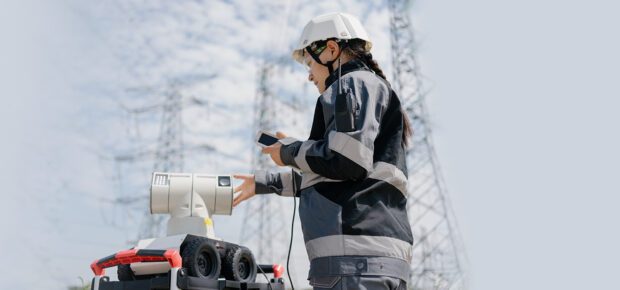January 25, 2023
In the United States, the average age of a bridge is 44 years. Sewage pipes are, on average, 45 years old; dams and levees more than 50 years old.
Aging infrastructure is a global phenomenon, one that requires significant resources to inspect and maintain. And sometimes, the areas under inspection are dangerous or inaccessible to humans.
Increasingly, robots are performing these inspections.
High voltage power lines, for example, have traditionally been inspected by humans that accessed them via helicopter. But specialized robots that can traverse these environments have been around for more than a decade.
We asked several IEEE Impact Creators about the current state of robotics in infrastructure assessment.
1. Robotics for inspection is in its infancy.
“The use of robots in well-defined and predictable environments like factories has been well established for many years. But robots often need to be deployed in extreme environments that have specific design demands.”
– Jayakrishnan Thrivikaman Nair, IEEE Member
2. New advancements in sensors and machine learning are making robots more autonomous.
“This increases safety, enables a broader network of zones to be addressed in a shorter period of time, even autonomously, and potentially at any time an urgent inspection may be required.”
– Eleanor Watson, IEEE Member
3. Robots come in all shapes and sizes – depending on the task.
“Due to the diversity and complexity of different industries and inspection tasks, there doesn’t seem to exist dominant form factors for these robots yet. However, the key technologies such as motion control, localization, sensor and actuator. We will likely see highly customizable and modularized solutions for inspection robots soon.”
– Guoliang Xing, IEEE Fellow
4. They see things humans can’t.
“New techniques such as sensor fusion enable multiple wavelengths of the electromagnetic spectrum to be spliced together to provide a more cohesive picture of a situation. Infrared might tell you one thing, and UV another. Moreover, the backscattering of radio waves can allow one to detect objects and movement even behind walls.”
– Eleanor Watson, IEEE Member
5. They can outperform humans in some tasks …
“In highly specialized sectors, like metal fatigue inspection, which largely relies on equipment in the first place, robots can be more accurate and more comprehensive.”
– Guoliang Xing, IEEE Fellow
6. … but don’t count humans out yet.
“Comparing humans and robots is a bit like comparing birds and airplanes. They can both perform similar functions, but in different ways, with differing constraints. Humans have a tremendous advantage in dexterity, flexibility towards different tasks, and modest logistical requirements. Robots are perfect for routine or dull work in dangerous environments, and with predictable opportunities to recharge and a non-urgent schedule.”
– Eleanor Watson, IEEE Member
7. And humans and robots work well together.
“Inspection tasks are done as a team. The robot acquires the data, and humans report on the acquired data.”
– Paulo Drews Jr., IEEE Senior member
8. They’re already building infrastructure, but they’ll be printing it in the future.
“Assembly, welding and material-handling robots have been widely used for construction purposes for many decades. Whereas during the last decade, robots that are capable of bricklaying, tile laying, plastering, wall painting etc., are increasingly used. The latest trend is using huge 3D printing robots for construction purposes. Due to the quick set-up time and scalability, these types of robots will undoubtedly revolutionize the construction industry in the near future”.
– Jayakrishnan Thrivikaman Nair, IEEE member
Learn More: Robotics has a large role to play in the fight against climate change. Hear some of the applications of robotics in agriculture, forestry management, and oceanography in this panel hosted by the IEEE Robotics and Automation Society.





 Meaningful Momentum or Running in Place?
Meaningful Momentum or Running in Place? AI Through Our Ages
AI Through Our Ages Liquid Infrastructure: Our Planet's Most Precious Resource
Liquid Infrastructure: Our Planet's Most Precious Resource The Impact of Technology in 2025
The Impact of Technology in 2025 Quantum and AI: Safeguards or Threats to Cybersecurity?
Quantum and AI: Safeguards or Threats to Cybersecurity? Why AI Can't Live Without Us
Why AI Can't Live Without Us Bits, Bytes, Buildings and Bridges: Digital-Driven Infrastructure
Bits, Bytes, Buildings and Bridges: Digital-Driven Infrastructure Impact of Technology in 2024
Impact of Technology in 2024 Emerging AI Cybersecurity Challenges and Solutions
Emerging AI Cybersecurity Challenges and Solutions The Skies are Unlimited
The Skies are Unlimited Smart Cities 2030: How Tech is Reshaping Urbanscapes
Smart Cities 2030: How Tech is Reshaping Urbanscapes Impact of Technology 2023
Impact of Technology 2023 Cybersecurity for Life-Changing Innovations
Cybersecurity for Life-Changing Innovations Smarter Wearables Healthier Life
Smarter Wearables Healthier Life Infrastructure In Motion
Infrastructure In Motion The Impact of Tech in 2022 and Beyond
The Impact of Tech in 2022 and Beyond Cybersecurity, Technology and Protecting Our World
Cybersecurity, Technology and Protecting Our World How Technology Helps us Understand Our Health and Wellness
How Technology Helps us Understand Our Health and Wellness The Resilience of Humanity
The Resilience of Humanity Harnessing and Sustaining our Natural Resources
Harnessing and Sustaining our Natural Resources Creating Healthy Spaces Through Technology
Creating Healthy Spaces Through Technology Exceptional Infrastructure Challenges, Technology and Humanity
Exceptional Infrastructure Challenges, Technology and Humanity The Global Impact of IEEE's 802 Standards
The Global Impact of IEEE's 802 Standards Scenes of our Cyber Lives: The Security Threats and Technology Solutions Protecting Us
Scenes of our Cyber Lives: The Security Threats and Technology Solutions Protecting Us How Millennial Parents are Embracing Health and Wellness Technologies for Their Generation Alpha Kids
How Millennial Parents are Embracing Health and Wellness Technologies for Their Generation Alpha Kids Space Exploration, Technology and Our Lives
Space Exploration, Technology and Our Lives Global Innovation and the Environment
Global Innovation and the Environment How Technology, Privacy and Security are Changing Each Other (And Us)
How Technology, Privacy and Security are Changing Each Other (And Us) Find us in booth 31506, LVCC South Hall 3 and experience the Technology Moon Walk
Find us in booth 31506, LVCC South Hall 3 and experience the Technology Moon Walk Virtual and Mixed Reality
Virtual and Mixed Reality How Robots are Improving our Health
How Robots are Improving our Health IEEE Experts and the Robots They are Teaching
IEEE Experts and the Robots They are Teaching See how millennial parents around the world see AI impacting the lives of their tech-infused offspring
See how millennial parents around the world see AI impacting the lives of their tech-infused offspring Take the journey from farm to table and learn how IoT will help us reach the rising demand for food production
Take the journey from farm to table and learn how IoT will help us reach the rising demand for food production Watch technical experts discuss the latest cyber threats
Watch technical experts discuss the latest cyber threats Explore how researchers, teachers, explorers, healthcare and medical professionals use immersive technologies
Explore how researchers, teachers, explorers, healthcare and medical professionals use immersive technologies Follow the timeline to see how Generation AI will be impacted by technology
Follow the timeline to see how Generation AI will be impacted by technology Learn how your IoT data can be used by experiencing a day in a connected life
Learn how your IoT data can be used by experiencing a day in a connected life Listen to technical experts discuss the biggest security threats today
Listen to technical experts discuss the biggest security threats today See how tech has influenced and evolved with the Games
See how tech has influenced and evolved with the Games Enter our virtual home to explore the IoT (Internet of Things) technologies
Enter our virtual home to explore the IoT (Internet of Things) technologies Explore an interactive map showcasing exciting innovations in robotics
Explore an interactive map showcasing exciting innovations in robotics Interactively explore A.I. in recent Hollywood movies
Interactively explore A.I. in recent Hollywood movies Get immersed in technologies that will improve patients' lives
Get immersed in technologies that will improve patients' lives